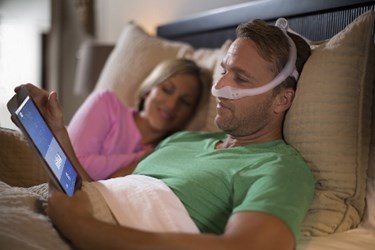Philips Introduces Next-Gen Sleep Apnea Therapy System

Philips Respironics has introduced new obstructive sleep apnea (OSA) technology — dubbed the Dream Family — that will help patients get better rest while being more engaged in their sleep therapy. The system’s mask is designed to allow patients to comfortably change positions while they sleep, and researchers claim the interactive features have improved treatment adherence by 22 percent.
Patients suffering from sleep apnea stop breathing repeatedly throughout the night, sometimes hundreds of times. OSA, the most common type of sleep apnea, is caused by a spontaneous and momentary collapse of soft tissue in the back of the throat. Because breath cessation is so brief, it fails to wake the patient, who is often unaware of the condition. According to the American Sleep Apnea Association, sleep apnea causes excessive fatigue and the development of high blood pressure, stroke, diabetes, and depression.
Sleep apnea is most commonly treated with continuous positive airway pressure (CPAP) devices that are worn while the patient is sleeping, but the masks are often cumbersome and difficult to sleep in, which increases the likelihood of noncompliance. DreamWear, a newly designed mask for the Dream Family System, reduces contact, clears the line of vision, and directs airflow through the sides of the mask so the patient may sleep comfortably in any position without adjusting the head straps.
“People struggling with sleep apnea face a range of issues — from finding the right mask to understanding how their therapy is working for them,” said Mark D’Angelo, Sleep Business Leader for Philips, in a press release. “At the end of the day, it’s about helping people feel less like they’re being treated for a condition, and more like they are now able to live their best life because they’re finally getting the sleep they need.”
D’Angelo explained that, in addition to an improved mask design, Philips also developed DreamStation — a connected device that can share a patient’s data with his or her clinician, supported by a comprehensive range of software that helps patients adjust to their sleep therapy, troubleshoot problems, and provide feedback. DreamMapper, an app that provides daily motivations and therapy advice, has been shown to improve adherence by 22 percent, said researchers.
Earlier this month, Philips announced that it would be strengthening its collaboration with Amazon Web Services, which will expand the connectivity and capability of Philips’ HealthSuite Digital Platform, a cloud-based platform for healthcare data developing in competition with Apple’s ResearchKit and Google Genomics.
“At Philips, we seek to empower consumers to be active participants in their own health. The digital health revolution and the power of the Internet of Things (IoT) offer tremendous opportunities to positively transform how care is delivered,” said Jeroen Tas, CEO of Philips Healthcare Informatics, Solutions and Services, in a press release.
The National Sleep Foundation estimates that 18 million Americans are currently living with sleep apnea, the same number of patients with Type II diabetes. Because it can only truly be diagnosed with a sleep study, experts say a majority of cases go untreated, despite serious consequences of the condition.
